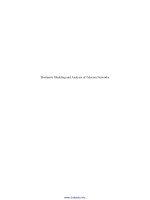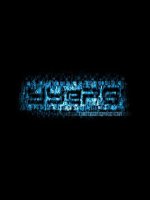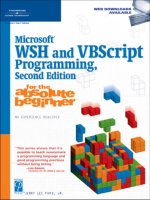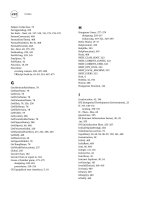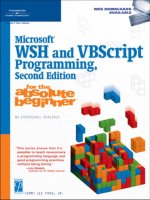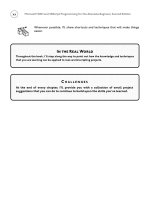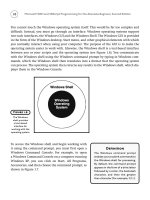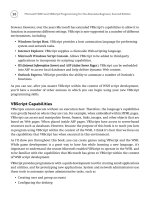3d modeling and animation synthesis and analysis techniques for the human body
Bạn đang xem bản rút gọn của tài liệu. Xem và tải ngay bản đầy đủ của tài liệu tại đây (10.14 MB, 408 trang )
3D Modeling
and Animation:
Synthesis and Analysis
Techniques for the
Human Body
Nikos Sarris
Michael G. Strintzis
IRM Press
3D Modeling
and
Animation:
Synthesis and Analysis
Techniques for the
Human Body
Nikos Sarris
Informatics & Telematics Institute, Greece
Michael G. Strintzis
Informatics & Telematics Institute, Greece
IRM Press
Publisher of innovative scholarly and professional
information technology titles in the cyberage
Hershey • London • Melbourne • Singapore
Acquisition Editor: Mehdi Khosrow-Pour
Senior Managing Editor: Jan Travers
Managing Editor: Amanda Appicello
Development Editor: Michele Rossi
Copy Editor: Bernard J. Kieklak, Jr.
Typesetter: Amanda Appicello
Cover Design: Shane Dillow
Printed at: Integrated Book Technology
Published in the United States of America by
IRM Press (an imprint of Idea Group Inc.)
701 E. Chocolate Avenue, Suite 200
Hershey PA 17033-1240
Tel: 717-533-8845
Fax: 717-533-8661
E-mail:
Web site:
and in the United Kingdom by
IRM Press (an imprint of Idea Group Inc.)
3 Henrietta Street
Covent Garden
London WC2E 8LU
Tel: 44 20 7240 0856
Fax: 44 20 7379 3313
Web site:
Copyright © 2005 by Idea Group Inc. All rights reserved. No part of this book may be repro-
duced in any form or by any means, electronic or mechanical, including photocopying, without
written permission from the publisher.
Library of Congress Cataloging-in-Publication Data
3d modeling and animation : synthesis and analysis techniques for the
human body / Nikos Sarris, Michael G. Strintzis, editors.
p. cm.
Includes bibliographical references and index.
ISBN 1-931777-98-5 (s/c) ISBN 1-931777-99-3 (ebook)
1. Computer animation. 2. Body, Human Computer simulation. 3.
Computer simulation. 4. Three-dimensional display systems. 5. Computer
graphics. I. Title: Three-D modeling and animation. II. Sarris, Nikos,
1971- III. Strintzis, Michael G.
TR897.7.A117 2005
006.6'93 dc22
2003017709
ISBN 1-59140-299-9 h/c
British Cataloguing in Publication Data
A Cataloguing in Publication record for this book is available from the British Library.
All work contributed to this book is new, previously-unpublished material. The views expressed in
this book are those of the authors, but not necessarily of the publisher.
3D Modeling and
Animation:
Synthesis and Analysis
Techniques for the Human Body
Table of Contents
Preface vi
Nikos Sarris, Informatics & Telematics Insistute, Greece
Michael G. Strintzis, Informatics & Telematics Insistute, Greece
Chapter I
Advances in Vision-Based Human Body Modeling 1
Angel Sappa, Computer Vision Center, Spain
Niki Aifanti, Informatics & Telematics Institute, Greece
Nikos Grammalidis, Informatics & Telematics Institute, Greece
Sotiris Malassiotis, Informatics & Telematics Institute, Greece
Chapter II
Virtual Character Definition and Animation within the
MPEG-4 Standard 27
Marius Preda, GET/Institut National des Télécommunications,
France
Ioan Alexandru Salomie, ETRO Department of the Vrije Universiteit
Brussel, Belgium
Françoise Preteux, GET/Institut National des Télécommunications,
France
Gauthier Lafruit, MICS-DESICS/Interuniversity MicroElectronics
Center (IMEC), Belgium
Chapter III
Camera Calibration for 3D Reconstruction and View
Transformation 70
B. J. Lei, Delft University of Technology, The Netherlands
E. A. Hendriks, Delft University of Technology, The Netherlands
Aggelos K. Katsaggelos, Northwestern University, USA
Chapter IV
Real-Time Analysis of Human Body Parts and Gesture-Activity
Recognition in 3D 130
Burak Ozer, Princeton University, USA
Tiehan Lv, Princeton University, USA
Wayne Wolf, Princeton University, USA
Chapter V
Facial Expression and Gesture Analysis for Emotionally-Rich
Man-Machine Interaction 175
Kostas Karpouzis, National Technical University of Athens,
Greece
Amaryllis Raouzaiou, National Technical University of Athens,
Greece
Athanasios Drosopoulos, National Technical University of Athens,
Greece
Spiros Ioannou, National Technical University of Athens, Greece
Themis Balomenos, National Technical University of Athens,
Greece
Nicolas Tsapatsoulis, National Technical University of Athens,
Greece
Stefanos Kollias, National Technical University of Athens, Greece
Chapter VI
Techniques for Face Motion & Expression Analysis on
Monocular Images 201
Ana C. Andrés del Valle, Institut Eurécom, France
Jean-Luc Dugelay, Institut Eurécom, France
Chapter VII
Analysis and Synthesis of Facial Expressions 235
Peter Eisert, Fraunhofer Institute for Telecommunications,
Germany
Chapter VIII
Modeling and Synthesis of Realistic Visual Speech in 3D 266
Gregor A. Kalberer, BIWI – Computer Vision Lab, Switzerland
Pascal Müller, BIWI – Computer Vision Lab, Switzerland
Luc Van Gool, BIWI – Computer Vision Lab, Switzerland and
VISICS, Belgium
Chapter IX
Automatic 3D Face Model Adaptation with Two Complexity
Modes for Visual Communication 295
Markus Kampmann, Ericsson Eurolab Deutschland GmbH,
Germany
Liang Zhang, Communications Research Centre, Canada
Chapter X
Learning 3D Face Deformation Model: Methods and Applications 317
Zhen Wen, University of Illinois at Urbana Champaign, USA
Pengyu Hong, Harvard University, USA
Jilin Tu, University of Illinois at Urbana Champaign, USA
Thomas S. Huang, University of Illinois at Urbana Champaign,
USA
Chapter XI
Synthesis and Analysis Techniques for the Human Body:
R&D Projects 341
Nikos Karatzoulis, Systema Technologies SA, Greece
Costas T. Davarakis, Systema Technologies SA, Greece
Dimitrios Tzovaras, Informatics & Telematics Institute,
Greece
About the Authors 376
Index 388
vi
Preface
The emergence of virtual reality applications and human-like interfaces has
given rise to the necessity of producing realistic models of the human body.
Building and animating a synthetic, cartoon-like, model of the human body has
been practiced for many years in the gaming industry and advances in the game
platforms have led to more realistic models, although still cartoon-like. The
issue of building a virtual human clone is still a matter of ongoing research and
relies on effective algorithms which will determine the 3D structure of an ac-
tual human being and duplicate this with a three-dimensional graphical model,
fully textured, by correct mapping of 2D images of the human on the 3D model.
Realistic human animation is also a matter of ongoing research and, in the case
of human cloning, relies on accurate tracking of the 3D motion of a human,
which has to be duplicated by his 3D model. The inherently complex articula-
tion of the human body imposes great difficulties in both the tracking and ani-
mation processes, which are being tackled by specific techniques, such as mod-
eling languages, as well as by standards developed for these purposes. Particu-
larly the human face and hands present the greatest difficulties in modeling and
animation due to their complex articulation and communicative importance in
expressing the human language and emotions.
Within the context of this book, we present the state-of-the-art methods for
analyzing the structure and motion of the human body in parallel with the most
effective techniques for constructing realistic synthetic models of virtual hu-
mans.
vii
The level of detail that follows is such that the book can prove useful to stu-
dents, researchers and software developers. That is, a level low enough to
describe modeling methods and algorithms without getting into image process-
ing and programming principles, which are not considered as prerequisite for
the target audience.
The main objective of this book is to provide a reference for the state-of-the-
art methods delivered by leading researchers in the area, who contribute to the
appropriate chapters according to their expertise. The reader is presented with
the latest, research-level, techniques for the analysis and synthesis of still and
moving human bodies, with particular emphasis on facial and gesture charac-
teristics.
Attached to this preface, the reader will find an introductory chapter which
revises the state-of-the-art on established methods and standards for the analysis
and synthesis of images containing humans. The most recent vision-based hu-
man body modeling techniques are presented, covering the topics of 3D human
body coding standards, motion tracking, recognition and applications. Although
this chapter, as well as the whole book, examines the relevant work in the
context of computer vision, references to computer graphics techniques are
given, as well.
The most relevant international standard established, MPEG-4, is briefly dis-
cussed in the introductory chapter, while its latest amendments, offering an
appropriate framework for the animation and coding of virtual humans, is de-
scribed in detail in Chapter 2. In particular, in this chapter Preda et al. show
how this framework is extended within the new MPEG-4 standardization pro-
cess by allowing the animation of any kind of articulated models, while address-
ing advanced modeling and animation concepts, such as “Skeleton, Muscle and
Skin”-based approaches.
The issue of camera calibration is of generic importance to any computer vision
application and is, therefore, addressed in a separate chapter by Lei, Hendriks
and Katsaggelos. Thus, Chapter 3 presents a comprehensive overview of pas-
sive camera calibration techniques by comparing and evaluating existing ap-
proaches. All algorithms are presented in detail so that they can be directly
implemented.
The detection of the human body and the recognition of human activities and
hand gestures from multiview images are examined by Ozer, Lv and Wolf in
viii
Chapter 4. Introducing the subject, the authors provide a review of the main
components of three-dimensional and multiview visual processing techniques.
The real-time aspects of these techniques are discussed and the ways in which
these aspects affect the software and hardware architectures are shown. The
authors also present the multiple-camera system developed by their group to
investigate the relationship between the activity recognition algorithms and the
architectures required to perform these tasks in real-time.
Gesture analysis is also discussed by Karpouzis et al. in Chapter 5, along with
facial expression analysis within the context of human emotion recognition. A
holistic approach to emotion modeling and analysis is presented along with ap-
plications in Man-Machine Interaction, aiming towards the next-generation in-
terfaces that will be able to recognize the emotional states of their users.
The face, being the most expressive and complex part of the human body, is the
object of discussion in the following five chapters as well. Chapter 6 examines
techniques for the analysis of facial motion aiming mainly to the understanding
of expressions from monoscopic images or image sequences. In Chapter 7
Eisert also addresses the same problem with his methods, paying particular
attention to understanding and normalizing the illumination of the scene.
Kalberer, Müller and Van Gool present their work in Chapter 8, extending the
state-of-the-art in creating highly realistic lip and speech-related facial motion.
The deformation of three-dimensional human face models guided by the facial
features captured from images or image sequences is examined in Chapters 9
and 10. Kampmann and Zhang propose a solution of varying complexity appli-
cable to video-conferencing systems, while Wen et al. present a framework,
based on machine learning, for the modeling, analysis and synthesis of facial
deformation.
The book concludes with Chapter 11, by Karatzoulis, Davarakis and Tzovaras,
providing a reference to current relevant R&D projects worldwide. This clos-
ing chapter presents a number of promising applications and provides an over-
view of recent developments and techniques in the area of analysis and synthe-
sis techniques for the human body. Technical details are provided for each
project and the provided results are also discussed and evaluated.
Advances in Vision-Based Human Body Modeling 1
Copyright © 2004, Idea Group Inc. Copying or distributing in print or electronic forms without written
permission of Idea Group Inc. is prohibited.
Chapter I
Advances in
Vision-Based Human
Body Modeling
Angel Sappa
Computer Vision Center, Spain
Niki Aifanti
Informatics & Telematics Institute, Greece
Nikos Grammalidis
Informatics & Telematics Institute, Greece
Sotiris Malassiotis
Informatics & Telematics Institute, Greece
Abstract
This chapter presents a survey of the most recent vision-based human body
modeling techniques. It includes sections covering the topics of 3D human
body coding standards, motion tracking, recognition and applications.
Short summaries of various techniques, including their advantages and
disadvantages, are introduced. Although this work is focused on computer
vision, some references from computer graphics are also given. Considering
that it is impossible to find a method valid for all applications, this chapter
2 Sappa, Aifanti, Grammalidis & Malassiotis
Copyright © 2004, Idea Group Inc. Copying or distributing in print or electronic forms without written
permission of Idea Group Inc. is prohibited.
intends to give an overview of the current techniques in order to help in the
selection of the most suitable method for a certain problem.
Introduction
Human body modeling is experiencing a continuous and accelerated growth. This
is partly due to the increasing demand from computer graphics and computer
vision communities. Computer graphics pursue a realistic modeling of both the
human body geometry and its associated motion. This will benefit applications
such as games, virtual reality or animations, which demand highly realistic
Human Body Models (HBMs). At the present, the cost of generating realistic
human models is very high, therefore, their application is currently limited to the
movie industry where HBM’s movements are predefined and well studied
(usually manually produced). The automatic generation of a realistic and fully
configurable HBM is still nowadays an open problem. The major constraint
involved is the computational complexity required to produce realistic models
with natural behaviors. Computer graphics applications are usually based on
motion capture devices (e.g., magnetic or optical trackers) as a first step, in order
to accurately obtain the human body movements. Then, a second stage involves
the manual generation of HBMs by using editing tools (several commercial
products are available on the market).
Recently, computer vision technology has been used for the automatic genera-
tion of HBMs from a sequence of images by incorporating and exploiting prior
knowledge of the human appearance. Computer vision also addresses human
body modeling, but in contrast to computer graphics it seeks more for an efficient
than an accurate model for applications such as intelligent video surveillance,
motion analysis, telepresence or human-machine interface. Computer vision
applications rely on vision sensors for reconstructing HBMs. Obviously, the rich
information provided by a vision sensor, containing all the necessary data for
generating a HBM, needs to be processed. Approaches such as tracking-
segmentation-model fitting or motion prediction-segmentation-model fitting
or other combinations have been proposed showing different performances
according to the nature of the scene to be processed (e.g indoor environments,
studio-like environments, outdoor environments, single-person scenes, etc). The
challenge is to produce a HBM able to faithfully follow the movements of a real
person.
Vision-based human body modeling combines several processing techniques
from different research areas which have been developed for a variety of
conditions (e.g., tracking, segmentation, model fitting, motion prediction, the
Advances in Vision-Based Human Body Modeling 3
Copyright © 2004, Idea Group Inc. Copying or distributing in print or electronic forms without written
permission of Idea Group Inc. is prohibited.
study of kinematics, the dynamics of articulated structures, etc). In the current
work, topics such as motion tracking and recognition and human body coding
standards will be particularly treated due to their direct relation with human body
modeling. Despite the fact that this survey will be focused on recent techniques
involving HBMs within the computer vision community, some references to
works from computer graphics will be given.
Due to widespread interest, there has been an abundance of work on human body
modeling during the last years. This survey will cover most of the different
techniques proposed in the bibliography, together with their advantages or
disadvantages. The outline of this work is as follows. First, geometrical primi-
tives and mathematical formalism, used for 3D model representation, are
addressed. Next, standards used for coding HBMs, as well as a survey about
human motion tracking and recognition are given. In addition, a summary of some
application works is presented. Finally, a section with a conclusion is introduced.
3D Human Body Modeling
Modeling a human body first implies the adaptation of an articulated 3D
structure, in order to represent the human body biomechanical features. Sec-
ondly, it implies the definition of a mathematical model used to govern the
movements of that articulated structure.
Several 3D articulated representations and mathematical formalisms have been
proposed in the literature to model both the structure and movements of a human
body. An HBM can be represented as a chain of rigid bodies, called links,
interconnected to one another by joints. Links are generally represented by
means of sticks (Barron & Kakadiaris, 2000), polyhedrons (Yamamoto et al.,
1998), generalized cylinders (Cohen, Medioni & Gu, 2001) or superquadrics
(Gavrila & Davis, 1996). A joint interconnects two links by means of rotational
motions about the axes. The number of independent rotation parameters will
define the degrees of freedom (DOF) associated with a given joint. Figure 1
(left) presents an illustration of an articulated model defined by 12 links (sticks)
and ten joints.
In computer vision, where models with only medium precision are required,
articulated structures with less than 30 DOF are generally adequate. For
example, Delamarre & Faugeras (2001) use a model of 22 DOF in a multi-view
tracking system. Gavrila & Davis (1996) also propose the use of a 22-DOF
model without modeling the palm of the hand or the foot and using a rigid head-
torso approximation. The model is defined by three DOFs for the positioning of
the root of the articulated structure, three DOFs for the torso and four DOFs for
4 Sappa, Aifanti, Grammalidis & Malassiotis
Copyright © 2004, Idea Group Inc. Copying or distributing in print or electronic forms without written
permission of Idea Group Inc. is prohibited.
each arm and each leg. The illustration presented in Figure 1 (left) corresponds
to an articulated model defined by 22 DOF.
On the contrary, in computer graphics, highly accurate representations consist-
ing of more than 50 DOF are generally selected. Aubel, Boulic & Thalmann
(2000) propose an articulated structure composed of 68 DOF. They correspond
to the real human joints, plus a few global mobility nodes that are used to orient
and position the virtual human in the world.
The simplest 3D articulated structure is a stick representation with no associated
volume or surface (Figure 1 (left)). Planar 2D representations, such as the
cardboard model, have also been widely used (Figure 1 (right)). However,
volumetric representations are preferred in order to generate more realistic
models (Figure 2). Different volumetric approaches have been proposed,
depending upon whether the application is in the computer vision or the computer
graphics field. On one hand, in computer vision, where the model is not the
purpose, but the means to recover the 3D world, there is a trade-off between
accuracy of representation and complexity. The utilized models should be quite
realistic, but they should have a low number of parameters in order to be
processed in real-time. Volumetric representations such as parallelepipeds,
Figure 1. Left: Stick representation of an articulated model defined by 22
DOF. Right: Cardboard person model.
3 DOF
1 DOF
3 DOF
3 DOF
1
DOF
3 DOF
Advances in Vision-Based Human Body Modeling 5
Copyright © 2004, Idea Group Inc. Copying or distributing in print or electronic forms without written
permission of Idea Group Inc. is prohibited.
cylinders (Figure 2 (left)), or superquadrics (Figure 2 (right)) have been largely
used. Delamarre & Faugeras (2001) propose to model a person by means of
truncated cones (arms and legs), spheres (neck, joints and head) and right
parallelepipeds (hands, feet and body). Most of these shapes can be modeled
using a compact and accurate representation called superquadrics. Superquadrics
are a family of parametric shapes that can model a large set of blob-like objects,
such as spheres, cylinders, parallelepipes and shapes in between. Moreover, they
can be deformed with tapering, bending and cavities (Solina & Bajcsy, 1990).
On the other hand, in computer graphics, accurate surface models consisting of
thousands of polygons are generally used. Plänkers & Fua (2001) and Aubel,
Boulic & Thalmann (2000) present a framework that retains an articulated
structure represented by sticks, but replace the simple geometric primitives by
soft objects. The result of this soft surface representation is a realistic model,
where body parts such as chest, abdomen or biceps muscles are well modeled.
By incorporating a mathematical model of human motion in the geometric
representation, the HBM comes alive, so that an application such as human body
tracking may be improved. There are a wide variety of ways to mathematically
model articulated systems from a kinematics and dynamics point of view. Much
of these materials come directly from the field of robotics (Paul, 1981; Craig
Figure 2. Left: Volumetric model defined by 10 cylinders – 22 DOF. Right:
Volumetric model built with a set of superquadrics – 22 DOF.
6 Sappa, Aifanti, Grammalidis & Malassiotis
Copyright © 2004, Idea Group Inc. Copying or distributing in print or electronic forms without written
permission of Idea Group Inc. is prohibited.
1989). A mathematical model will include the parameters that describe the links,
as well as information about the constraints associated with each joint. A model
that only includes this information is called a kinematic model and describes the
possible static states of a system. The state vector of a kinematic model consists
of the model state and the model parameters. A system in motion is modeled
when the dynamics of the system are modeled as well. A dynamic model
describes the state evolution of the system over time. In a dynamic model, the
state vector includes linear and angular velocities, as well as position (Wren &
Pentland, 1998).
After selecting an appropriate model for a particular application, it is necessary
to develop a concise mathematical formulation for a general solution to the
kinematics and dynamics problem, which are non-linear problems. Different
formalism have been proposed in order to assign local reference frames to the
links. The simplest approach is to introduce joint hierarchies formed by indepen-
dent articulation of one DOF, described in terms of Euler angles. Hence, the body
posture is synthesized by concatenating the transformation matrices associated
with the joints, starting from the root. Despite the fact that this formalism suffers
from singularities, Delamarre & Faugeras (2001) propose the use of composi-
tions of translations and rotations defined by Euler angles. They solve the
singularity problems by reducing the number of DOFs of the articulation.
3D Human Body Coding Standards
As it was mentioned in the previous section, an HBM consists of a number of
segments that are connected to each other by joints. This physical structure can
be described in many different ways. However, in order to animate or inter-
change HBMs, a standard representation is required. This standardization allows
compatibility between different HBM processing tools (e.g., HBMs created
using one editing tool could be animated using another completely different tool).
In the following, the Web3D H-anim standards, the MPEG-4 face and body
animation, as well as MPEG-4 AFX extensions for humanoid animation, are
briefly introduced.
The Web3D H-Anim Standards
The Web3D H-anim working group (H-anim) was formed so that developers
could agree on a standard naming convention for human body parts and joints.
The human form has been studied for centuries and most of the parts already
Advances in Vision-Based Human Body Modeling 7
Copyright © 2004, Idea Group Inc. Copying or distributing in print or electronic forms without written
permission of Idea Group Inc. is prohibited.
have medical (or Latin) names. This group has produced the Humanoid
Animation Specification (H-anim) standards, describing a standard way of
representing humanoids in VRML. These standards allow humanoids created
using authoring tools from one vendor to be animated using tools from another.
H-anim humanoids can be animated using keyframing, inverse kinematics,
performance animation systems and other techniques. The three main design
goals of H-anim standards are:
• Compatibility: Humanoids should be able to display/animate in any VRML
compliant browser.
• Flexibility: No assumptions are made about the types of applications that
will use humanoids.
• Simplicity: The specification should contain only what is absolutely neces-
sary.
Up to now, three H-anim standards have been produced, following developments
in VRML standards, namely the H-anim 1.0, H-anim 2.0 and H-anim 2001
standards.
The H-anim 1.0 standard specified a standard way of representing humanoids in
VRML 2.0 format. The VRML Humanoid file contains a set of Joint nodes, each
defining the rotation center of a joint, which are arranged to form a hierarchy.
The most common implementation for a joint is a VRML Transform node, which
is used to define the relationship of each body segment to its immediate parent,
although more complex implementations can also be supported. Each Joint node
can contain other Joint nodes and may also contain a Segment node, which
contains information about the 3D geometry, color and texture of the body part
associated with that joint. Joint nodes may also contain hints for inverse-
kinematics systems that wish to control the H-anim figure, such as the upper and
lower joint limits, the orientation of the joint limits, and a stiffness/resistance
value. The file also contains a single Humanoid node, which stores human-
readable data about the humanoid, such as author and copyright information. This
node also stores references to all the Joint and Segment nodes. Additional nodes
can be included in the file, such as Viewpoints, which may be used to display the
figure from several different perspectives.
The H-anim 1.1 standard has extended the previous version in order to specify
humanoids in the VRML97 standard (successor of VRML 2.0). New features
include Site nodes, which define specific locations relative to the segment, and
Displacer nodes that specify which vertices within the segment correspond to
a particular feature or configuration of vertices. Furthermore, a Displacer node
may contain “hints” as to the direction in which each vertex should move, namely
8 Sappa, Aifanti, Grammalidis & Malassiotis
Copyright © 2004, Idea Group Inc. Copying or distributing in print or electronic forms without written
permission of Idea Group Inc. is prohibited.
a maximum 3-D displacement for each vertex. An application may uniformly
scale these displacements before applying them to the corresponding vertices.
For example, this field is used to implement Facial Definition and Animation
Parameters of the MPEG-4 standard (FDP/FAP).
Finally, the H-anim 2001 standard does not introduce any major changes, e.g.,
new nodes, but provides better support of deformation engines and animation
tools. Additional fields are provided in the Humanoid and the Joint nodes to
support continuous mesh avatars and a more general context-free grammar is
used to describe the standard (instead of pure VRML97, which is used in the two
older H-anim standards). More specifically, a skeletal hierarchy can be defined
for each H-anim humanoid figure within a Skeleton field of the Humanoid node.
Then, an H-anim humanoid figure can be defined as a continuous piece of
geometry, within a Skin field of the Humanoid node, instead of a set of discrete
segments (corresponding to each body part), as in the previous versions. This
Skin field contains an indexed face set (coordinates, topology and normals of skin
nodes). Each Joint node also contains a SkinCoordWeight field, i.e., a list of
floating point values, which describes the amount of “weighting” that should be
used to affect a particular vertex from a SkinCoord field of the Humanoid node.
Each item in this list has a corresponding index value in the SkinCoordIndex
field of the Joint node, which indicates exactly which coordinate is to be
influenced.
Face and Body Animation in the MPEG-4 Standard
The MPEG-4 SNHC (Synthetic and Natural Hybrid Coding) group has standard-
ized two types of streams in order to animate avatars:
• The Face/Body Definition Parameters (FDP/BDP) are avatar-specific
and based on the H-anim specifications. More precisely the MPEG-4 BDP
Node contains the H-anim Humanoid Node.
• The Face/Body Animation Parameters (FAP/BAP) are used to animate
face/body models. More specifically, 168 Body Animation Parameters
(BAPs) are defined by MPEG-4 SNHC to describe almost any possible
body posture. A single set of FAPs/BAPs can be used to describe the face/
body posture of different avatars. MPEG-4 has also standardized the
compressed form of the resulting animation stream using two techniques:
DCT-based or prediction-based. Typical bit-rates for these compressed
bit-streams are two kbps for the case of facial animation or 10 to 30 kbps
for the case of body animation.
Advances in Vision-Based Human Body Modeling 9
Copyright © 2004, Idea Group Inc. Copying or distributing in print or electronic forms without written
permission of Idea Group Inc. is prohibited.
In addition, complex 3D deformations that can result from the movement of
specific body parts (e.g., muscle contraction, clothing folds, etc.) can be modeled
by using Face/Body Animation Tables (FAT/BATs). These tables specify a set
of vertices that undergo non-rigid motion and a function to describe this motion
with respect to the values of specific FAPs/BAPs. However, a significant
problem with using FAT/BAT Tables is that they are body model-dependent and
require a complex modeling stage. On the other hand, BATs can prevent
undesired body animation effects, such as broken meshes between two linked
segments. In order to solve such problems, MPEG-4 addresses new animation
functionalities in the framework of AFX group (a preliminary specification has
been released in January 2002) by including also a generic seamless virtual model
definition and bone-based animation. Particularly, the AFX specification de-
scribes state of the art components for rendering geometry, textures, volumes
and animation. A hierarchy of geometry, modeling, physics and biomechanical
models are described along with advanced tools for animating these models.
AFX Extensions for Humanoid Animation
The new Humanoid Animation Framework, defined by MPEG-4 SNHC (Preda,
2002; Preda & Prêteux, 2001) is defined as a biomechanical model in AFX and
is based on a rigid skeleton. The skeleton consists of bones, which are rigid
objects that can be transformed (rotated around specific joints), but not de-
formed. Attached to the skeleton, a skin model is defined, which smoothly
follows any skeleton movement.
More specifically, defining a skinned model involves specifying its static and
dynamic (animation) properties. From a geometric point of view, a skinned model
consists of a single list of vertices, connected as an indexed face set. All the
shapes, which form the skin, share the same list of vertices, thus avoiding seams
at the skin level during animation. However, each skin facet can contain its own
set of color, texture and material attributes.
The dynamic properties of a skinned model are defined by means of a skeleton
and its properties. The skeleton is a hierarchical structure constructed from
bones, each having an influence on the skin surface. When bone position or
orientation changes, e.g., by applying a set of Body Animation Parameters,
specific skin vertices are affected. For each bone, the list of vertices affected
by the bone motion and corresponding weight values are provided. The weighting
factors can be specified either explicitly for each vertex or more compactly by
defining two influence regions (inner and outer) around the bone. The new
position of each vertex is calculated by taking into account the influence of each
bone, with the corresponding weight factor. BAPs are now applied to bone nodes
10 Sappa, Aifanti, Grammalidis & Malassiotis
Copyright © 2004, Idea Group Inc. Copying or distributing in print or electronic forms without written
permission of Idea Group Inc. is prohibited.
and the new 3D position of each point in the global seamless mesh is computed
as a weighted combination of the related bone motions.
The skinned model definition can also be enriched with inverse kinematics-
related data. Then, bone positions can be determined by specifying only the
position of an end effector, e.g., a 3D point on the skinned model surface. No
specific inverse kinematics solver is imposed, but specific constraints at bone
level are defined, e.g., related to the rotation or translation of a bone in a certain
direction. Also muscles, i.e., NURBS curves with an influence region on the
model skin, are supported. Finally, interpolation techniques, such as simple linear
interpolation or linear interpolation between two quaternions (Preda & Prêteux,
2001), can be exploited for key-value-based animation and animation compres-
sion.
Human Motion Tracking and
Recognition
Tracking and recognition of human motion has become an important research
area in computer vision. Its numerous applications contributed significantly to
this development. Human motion tracking and recognition encompasses chal-
lenging and ill-posed problems, which are usually tackled by making simplifying
assumptions regarding the scene or by imposing constraints on the motion.
Constraints, such as making sure that the contrast between the moving people
and the background should be high and that everything in the scene should be
static except for the target person, are quite often introduced in order to achieve
accurate segmentation. Moreover, assumptions such as the lack of occlusions,
simple motions and known initial position and posture of the person, are usually
imposed on the tracking processes. However, in real-world conditions, human
motion tracking constitutes a complicated problem, considering cluttered back-
grounds, gross illumination variations, occlusions, self-occlusions, different
clothing and multiple moving objects.
The first step towards human tracking is the segmentation of human figures from
the background. This problem is addressed either by exploiting the temporal
relation between consecutive frames, i.e., by means of background subtraction
(Sato & Aggarwal, 2001), optical flow (Okada, Shirai & Miura, 2000) or by
modeling the image statistics of human appearance (Wren et al., 1997). The
output of the segmentation, which could be edges, silhouettes, blobs etc.,
comprises the basis for feature extraction. In tracking, feature correspondence
Advances in Vision-Based Human Body Modeling 11
Copyright © 2004, Idea Group Inc. Copying or distributing in print or electronic forms without written
permission of Idea Group Inc. is prohibited.
is established in order to locate the subject. Tracking through consecutive frames
commonly incorporates prediction of movement, which ensures continuity of
motion, especially when some body parts are occluded. Some techniques focus
on tracking the human body as a whole, while other techniques try to determine
the precise movement of each body part, which is more difficult to achieve, but
necessary for some applications. Tracking may be classified as 2D or 3D. 2D
tracking consists in following the motion in the image plane either by exploiting
low-level image features or by using a 2D human model. 3D tracking aims at
obtaining the parameters, which describe body motion in three dimensions. The
3D tracking process, which estimates the motion of each body part, is inherently
connected to 3D human pose recovery. However, tracking either 2D or 3D may
also comprise a prior, but significant, step to recognition of specific movements.
3D pose recovery aims at defining the configuration of the body parts in the 3D
space and estimating the orientation of the body with respect to the camera. Pose
recovery techniques may be roughly classified as appearance-based and model-
based. Our survey will mainly focus on model-based techniques, since they are
commonly used for 3D reconstruction. Model-based techniques rely on a
mathematical representation of human body structure and motion dynamics. The
type of the model used depends upon the requisite accuracy and the permissible
complexity of pose reconstruction. Model-based approaches usually exploit the
kinematics and dynamics of the human body by imposing constraints on the
model’s parameters. The 3D pose parameters are commonly estimated by
iteratively matching a set of image features extracted from the current frame
with the projection of the model on the image plane. Thus, 3D pose parameters
are determined by means of an energy minimization process.
Instead of obtaining the exact configuration of the human body, human motion
recognition consists of identifying the action performed by a moving person.
Most of the proposed techniques focus on identifying actions belonging to the
same category. For example, the objective could be to recognize several aerobic
exercises or tennis strokes or some everyday actions, such as sitting down,
standing up, or walking.
Next, some of the most recent results addressing human motion tracking and 3D
human pose recovery in video sequences, using either one or multiple cameras,
are presented. In this subsection, mainly 3D model-based tracking approaches
are reviewed. The following subsection introduces whole-body human motion
recognition techniques. Previous surveys of vision-based human motion analysis
have been carried out by Cédras & Shah (1995), Aggarwal & Cai (1999), Gavrila
(1999), and Moeslund & Granum (2001).
12 Sappa, Aifanti, Grammalidis & Malassiotis
Copyright © 2004, Idea Group Inc. Copying or distributing in print or electronic forms without written
permission of Idea Group Inc. is prohibited.
Human Motion Tracking and 3D Pose Recovery
The majority of model-based human motion tracking techniques may be classi-
fied into two main categories. The first one explicitly poses kinematic constraints
to the model parameters, for example, by means of Kalman filtering or physics-
based modeling. The second one is based on learning the dynamics of low-level
features or high-level motion attributes from a set of representative image
sequences, which are then used to constrain the model motion, usually within a
probabilistic tracking framework. Other subdivisions of the existing techniques
may rely on the type of the model or the type of image features (edges, blobs,
texture) used for tracking.
Tracking relies either on monocular or multiple camera image sequences. This
comprises the classification basis in this subsection. Using monocular image
sequences is quite challenging, due to occlusions of body parts and ambiguity in
recovering their structure and motion from a single perspective view (different
configurations have the same projection). On the other hand, single camera
views are more easily obtained and processed than multiple camera views.
In one of the most recent approaches (Sminchisescu & Triggs, 2001), 3D human
motion tracking from monocular sequences is achieved by fitting a 3D human
body model, consisting of tampered superellipsoids, on image features by means
of an iterative cost function optimization scheme. The disadvantage of iterative
model fitting techniques is the possibility of being trapped in local minima in the
multidimensional space of DOF. A multiple-hypothesis approach is proposed
with the ability of escaping local minima in the cost function. This consists of
observing that local minima are most likely to occur along local valleys in the cost
surface. In comparison with other stochastic sampling approaches, improved
tracking efficiency is claimed.
In the same context, the algorithm proposed by Cham & Rehg (1999) focuses on
2D image plane human motion using a 2D model with underlying 3D kinematics.
A combination of CONDENSATION style sampling with local optimization is
proposed. The probability density distribution of the tracker state is represented
as a set of modes with piece-wise Gaussians characterizing the neighborhood
around these modes. The advantage of this technique is that it does not require
the use of discrete features and is suitable for high-dimensional state-spaces.
Probabilistic tracking such as CONDENSATION has been proven resilient to
occlusions and successful in avoiding local minima. Unfortunately, these ad-
vances come at the expense of computational efficiency. To avoid the cost of
learning and running a probabilistic tracker, linear and linearised prediction
techniques, such as Kalman or extended Kalman filtering, have been proposed.
In this case, a strategy to overcome self-occlusions is required. More details on
Advances in Vision-Based Human Body Modeling 13
Copyright © 2004, Idea Group Inc. Copying or distributing in print or electronic forms without written
permission of Idea Group Inc. is prohibited.
CONDENSATION algorithms used in tracking and a comparison with the
Kalman filters can be found in Isard & Blake (1998).
In Wachter & Nagel (1999), a 3D model composed of right-elliptical cones is
fitted to consecutive frames by means of an iterated extended Kalman filter. A
motion model of constant velocity for all DOFs is used for prediction, while the
update of the parameters is based on a maximum a-posteriori estimation
incorporating edge and region information. This approach is able to cope with
self-occlusions occurring between the legs of a walking person. Self-occlusions
are also tackled in a Bayesian tracking system presented in Howe, Leventon &
Freeman (1999). This system tracks human figures in short monocular se-
quences and reconstructs their motion in 3D. It uses prior information learned
from training data. Training data consists of a vector gathered over 11 succes-
sive frames representing the 3D coordinates of 20 tracked body points and is
used to build a mixture-of-Gaussians probability density model. 3D reconstruc-
tion is achieved by establishing correspondence between the training data and
the features extracted. Sidenbladh, Black & Sigal (2002) also use a probabilistic
approach to address the problem of modeling 3D human motion for synthesis and
tracking. They avoid the high dimensionality and non-linearity of body movement
modeling by representing the posterior distribution non-parametrically. Learning
state transition probabilities is replaced with an efficient probabilistic search in
a large training set. An approximate probabilistic tree-search method takes
advantage of the coefficients of a low-dimensional model and returns a particular
sample human motion.
In contrast to single-view approaches, multiple camera techniques are able to
overcome occlusions and depth ambiguities of the body parts, since useful motion
information missing from one view may be recovered from another view.
A rich set of features is used in Okada, Shirai & Miura (2000) for the estimation
of the 3D translation and rotation of the human body. Foreground regions are
extracted by combining optical flow, depth (which is calculated from a pair of
stereo images) and prediction information. 3D pose estimation is then based on
the position and shape of the extracted region and on past states using Kalman
filtering. The evident problem of pose singularities is tackled probabilistically.
A framework for person tracking in various indoor scenes is presented in Cai &
Aggarwal (1999), using three synchronized cameras. Though there are three
cameras, tracking is actually based on one camera view at a time. When the
system predicts that the active camera no longer provides a sufficient view of
the person, it is deactivated and the camera providing the best view is selected.
Feature correspondence between consecutive frames is achieved using Baye-
sian classification schemes associated with motion analysis in a spatial-temporal
domain. However, this method cannot deal with occlusions above a certain level.
14 Sappa, Aifanti, Grammalidis & Malassiotis
Copyright © 2004, Idea Group Inc. Copying or distributing in print or electronic forms without written
permission of Idea Group Inc. is prohibited.
Dockstader & Tekalp (2001) introduce a distributed real-time platform for
tracking multiple interacting people using multiple cameras. The features
extracted from each camera view are independently processed. The resulting
state vectors comprise the input to a Bayesian belief network. The observations
of each camera are then fused and the most likely 3D position estimates are
computed. A Kalman filter performs state propagation in time. Multi-viewpoints
and a viewpoint selection strategy are also employed in Utsumi et al. (1998) to
cope with self-occlusions and human-human occlusions. In this approach,
tracking is based on Kalman filtering estimation as well, but it is decomposed into
three sub-tasks (position detection, rotation angle estimation and body-side
detection). Each sub-task has its own criterion for selecting viewpoints, while the
result of one sub-task can help estimation in another sub-task.
Delamarre & Faugeras (2001) proposed a technique which is able to cope not
only with self-occlusions, but also with fast movements and poor quality images,
using two or more fixed cameras. This approach incorporates physical forces to
each rigid part of a kinematic 3D human body model consisting of truncated
cones. These forces guide the 3D model towards a convergence with the body
posture in the image. The model’s projections are compared with the silhouettes
extracted from the image by means of a novel approach, which combines the
Maxwell’s demons algorithm with the classical ICP algorithm.
Some recently published papers specifically tackle the pose recovery problem
using multiple sensors. A real-time method for 3D posture estimation using
trinocular images is introduced in Iwasawa et al. (2000). In each image the
human silhouette is extracted and the upper-body orientation is detected. With
a heuristic contour analysis of the silhouette, some representative points, such as
the top of the head are located. Two of the three views are finally selected in
order to estimate the 3D coordinates of the representative points and joints. It is
experimentally shown that the view-selection strategy results in more accurate
estimates than the use of all views.
Multiple views in Rosales et al. (2001) are obtained by introducing the concept
of “virtual cameras”, which is based on the transformation invariance of the Hu
moments. One advantage of this approach is that no camera calibration is
required. A Specialized Mappings Architecture is proposed, which allows direct
mapping of the image features to 2D image locations of body points. Given
correspondences of the most likely 2D joint locations in virtual camera views, 3D
body pose can be recovered using a generalized probabilistic structure from
motion technique.
Advances in Vision-Based Human Body Modeling 15
Copyright © 2004, Idea Group Inc. Copying or distributing in print or electronic forms without written
permission of Idea Group Inc. is prohibited.
Human Motion Recognition
Human motion recognition may also be achieved by analyzing the extracted 3D
pose parameters. However, because of the extra pre-processing required,
recognition of human motion patterns is usually achieved by exploiting low-level
features (e.g., silhouettes) obtained during tracking.
Continuous human activity (e.g., walking, sitting down, bending) is separated in
Ali & Aggarwal (2001) into individual actions using one camera. In order to
detect the commencement and termination of actions, the human skeleton is
extracted and the angles subtended by the torso, the upper leg and the lower leg,
are estimated. Each action is then recognized based on the characteristic path
that these angles traverse. This technique, though, relies on lateral views of the
human body.
Park & Aggarwal (2000) propose a method for separating and classifying not
one person’s actions, but two humans’ interactions (shaking hands, pointing at
the opposite person, standing hand-in-hand) in indoor monocular grayscale
images with limited occlusions. The aim is to interpret interactions by inferring
the intentions of the persons. Recognition is independently achieved in each
frame by applying the K-nearest-neighbor classifier to a feature vector, which
describes the interpersonal configuration. In Sato & Aggarwal (2001), human
interaction recognition is also addressed. This technique uses outdoor monocular
grayscale images that may cope with low-quality images, but is limited to
movements perpendicular to the camera. It can classify nine two-person
interactions (e.g., one person leaves another stationary person, two people meet
from different directions). Four features are extracted (the absolute velocity of
each person, their average size, the relative distance and its derivative) from the
trajectory of each person. Identification is based on the feature’s similarity to an
interaction model using the nearest mean method.
Action and interaction recognition, such as standing, walking, meeting people and
carrying objects, is addressed by Haritaoglu, Harwood & Davis (1998, 2000). A
real-time tracking system, which is based on outdoor monocular grayscale
images taken from a stationary visible or infrared camera, is introduced.
Grayscale textural appearance and shape information of a person are combined
to a textural temporal template, which is an extension of the temporal templates
defined by Bobick & Davis (1996).
Bobick & Davis (1996) introduced a real-time human activity recognition
method, which is based on a two-component image representation of motion. The
first component (Motion Energy Image, MEI) is a binary image, which displays
where motion has occurred during the movement of the person. The second one
(Motion History Image, MHI) is a scalar image, which indicates the temporal

